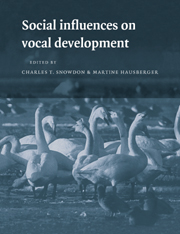Book contents
- Frontmatter
- Contents
- List of contributor
- 1 Introduction
- 2 Social interaction and sensitive phases for song learning: A critical review
- 3 Social interaction and vocal development in birds
- 4 Building a social agenda for the study of bird song
- 5 Field observations, experimental design, and the time and place of learning bird songs
- 6 Vocal learning in wild and domesticated zebra finches: Signature cues for kin recognition or epiphenomena?
- 7 What birds with complex social relationships can tell us about vocal learning: Vocal sharing in avian groups
- 8 Social influences on song acquisition and sharing in the European starling (Sturnus vulgaris)
- 9 Social influences on the acquisition of human-based codes in parrots and nonhuman primates
- 10 Vocal learning in captive bottlenose dolphins: A comparison with humans and nonhuman animals
- 11 Vocal learning in cetaceans
- 12 Social influences on vocal development in New World primates
- 13 Some general features of vocal development in nonhuman primates
- 14 Social influences on vocal learning in human and nonhuman primates
- 15 The resilience of language in humans
- 16 Reciprocal interactions and the development of communication and language between parents and children
- 17 Crafting activities: Building social organization through language in girls' and boys' groups
- Index
15 - The resilience of language in humans
Published online by Cambridge University Press: 04 August 2010
- Frontmatter
- Contents
- List of contributor
- 1 Introduction
- 2 Social interaction and sensitive phases for song learning: A critical review
- 3 Social interaction and vocal development in birds
- 4 Building a social agenda for the study of bird song
- 5 Field observations, experimental design, and the time and place of learning bird songs
- 6 Vocal learning in wild and domesticated zebra finches: Signature cues for kin recognition or epiphenomena?
- 7 What birds with complex social relationships can tell us about vocal learning: Vocal sharing in avian groups
- 8 Social influences on song acquisition and sharing in the European starling (Sturnus vulgaris)
- 9 Social influences on the acquisition of human-based codes in parrots and nonhuman primates
- 10 Vocal learning in captive bottlenose dolphins: A comparison with humans and nonhuman animals
- 11 Vocal learning in cetaceans
- 12 Social influences on vocal development in New World primates
- 13 Some general features of vocal development in nonhuman primates
- 14 Social influences on vocal learning in human and nonhuman primates
- 15 The resilience of language in humans
- 16 Reciprocal interactions and the development of communication and language between parents and children
- 17 Crafting activities: Building social organization through language in girls' and boys' groups
- Index
Summary
INTRODUCTION
In 1974, Ernst Mayr published a now classic paper on the distinction between innate and acquired characteristics. In this work, Mayr broke away from some of the more confining features of traditional accounts of innateness, and proposed a dimension along which behaviors might be expected to vary with respect to innateness. Mayr proposed a distinction between “closed” and “open” programs1 – a program that does not allow appreciable modifications during the lifespan of its owner is a “closed” program, while a program that does allow for the effects of additional input is “open.” Since it seems unlikely that any developmental program can be completely closed, Wimsatt (1986) has suggested that Mayr's notion of a closed program may be most fruitfully viewed as a relative one – “relative to the period of time of development under investigation, and the class of inputs being investigated, and probably also to the environment and the prior state of the developing phenotype” (Wimsatt 1986, p. 203). In Wimsatt's terms, a closed developmental program is one which is canalized with respect to the relevant inputs.
Mayr's classificatory schemes distinguished two types of behavior: A behavior is considered communicative if it is directed toward a recipient who is capable of responding with behavior of its own, and noncommunicative if it is directed toward a “recipient” that is passive and does not itself react (e.g., behaviors involved in selecting a habitat or seeking food).
- Type
- Chapter
- Information
- Social Influences on Vocal Development , pp. 293 - 311Publisher: Cambridge University PressPrint publication year: 1997
- 6
- Cited by

